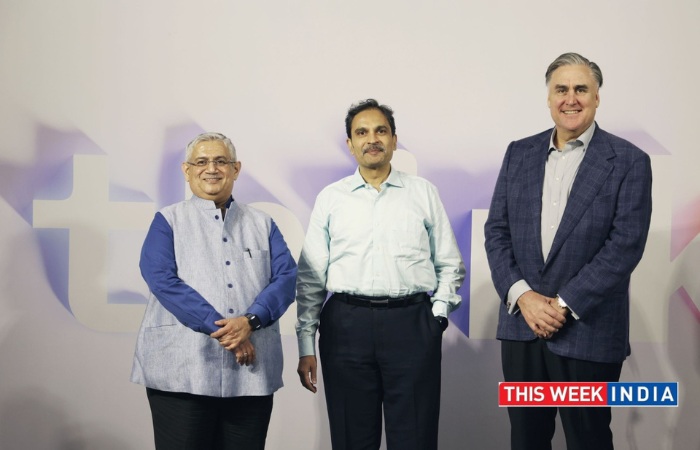By Madhvi Latha Laakkakula , Data Scientist
India’s use of AI has grown since 2018, thanks to efforts from the public, commercial, and scientific sectors. AI has advantages in productivity and problem-solving, but it also has drawbacks and hazards. The ethics and governance of AI are changing globally, and in India, these values coincide with fundamental rights. The secret to striking a balance between risk management and creativity is to put these ideas into practice.
The goal of AI strategy is to provide inclusive benefits through responsible adoption and public trust. The market for artificial intelligence is divided into three segments: application (i.e., goods tailored to a particular sector), technology (i.e., supporting technologies), and basic (i.e., parts and algorithms). Driven by rising automation and technological improvements, the AI market in India is expected to rise significantly and offer insights for well-informed investment decisions.
The fundamental layer (basic components and algorithms), the technology layer (supporting technologies), and the application layer (industry-specific AI solutions) are the three categories that make up the AI market.
Companies can focus on one or all three categories, demonstrating the range of areas of focus within the sector. The industry’s usage of AI, growing automation, and technological advancements are anticipated to drive the profession. The report offers insights into market dynamics, trends, and opportunities to support investors in making informed decisions as the AI sector evolves.
Expert systems, integral to AI development, emulate human intelligence and are deployed across diverse fields such as science, agriculture, education, and the military. These systems support critical functions ranging from educational resource management to military strategy and disaster prediction in geology.
An expert system is a computer program that is designed to emulate and mimic human intelligence, skills or behavior. It is mainly developed using artificial intelligence concepts, tools and technologies, and possesses expert knowledge in a particular field, topic or skill.
Expert systems are used in diverse fields, including science, agriculture, education, and the military. Here are some specific applications:
- Education: Utilized for educational resources management, academic performance analysis, psychological quality assessment, and online teaching.
- Military: Used for strategic planning, forecasting, combat simulation, and command and decision making.
- Agriculture: Assist in yield and benefit indexing, diagnosing problems, and providing solutions.
- Medical: Aid in explanation, prediction, diagnosis, and treatment planning.
- Geology: Employed for geological disaster prediction, engineering risk assessment, and construction countermeasures.
- Chemistry: Applied in chemical synthesis design, physical property estimation, equipment selection, and process synthesis.
With AI, 50% of security and service tasks can be automated, significantly reducing labor costs and minimizing errors and allowing organizations to reallocate human resources strategically.
Use Case: AI in Vision technology
The multidisciplinary area of computer vision (CV) studies how computers can comprehend digital pictures or movies at a high degree. From an engineering standpoint, its goal is to mechanize processes that the human visual system is capable of doing.
The technology and techniques used to offer imaging-based automatic inspection and analysis for applications including process control, robot guiding, and automatic inspection are known as machine vision (MV), and they are often utilized in industry.
Where computer vision is used?
- Smart phones
- Security image analysis
- Advertising and marketing
- Pan-Authentication(financial)
- Internet entertainment
Financial authentication – Card identification, document identification, fingerprint identification, face verification and iris verification technologies can verify the identity of customers, conduct remote business and extract key information from documents.
Advertising and marketing – Image recognition technology helps clients better understand
products and provides more advertising space for merchants. Intelligent analysis of video content, the placement of advertising in the corresponding scene can enhance the effect.
Security image analysis – Face recognition and video monitoring technology can quickly identify people, verify suspects, and analyze the subjects actions and behavior trajectory. They also can be used for public security control, traffic security, and criminal investigation.
Vision technology consumer analysis
VISION TECHNOLOGY USERS
Government utilizes its extensive video surveillance system to track down criminals. This includes crowd analysis, preventing incidents, and issuing early warnings in busy transportation hubs.
In the financial sector, advancements in identification and intelligent payment systems enhance security and transaction efficiency. These innovations enable remote account opening, cardless cash withdrawals, and streamlined transaction confirmations.
Media companies employ technology to create interactive advertising scenarios, leveraging intelligent image content mining to revolutionize marketing strategies.
Internet companies focus on image enhancement, augmented reality, and advanced editing tools for images and videos. These technologies facilitate easier product access through visual search and in-image purchasing.
Smartphone manufacturers integrate facial recognition for secure payments, identity verification, album organization, and photo editing.
Conclusion
Machine vision (MV) represents advanced technology and methodologies designed to deliver automated imaging-based inspection and analysis capabilities. It plays a crucial role across various industrial applications, including process control, robot guidance, and automatic inspection. By harnessing sophisticated imaging techniques, machine vision enhances operational efficiency, quality control, and precision in manufacturing and other sectors where accuracy and reliability are paramount. This technology enables real-time assessment and decision-making, contributing significantly to streamlined processes, improved productivity, and enhanced quality assurance standards within industrial settings.








